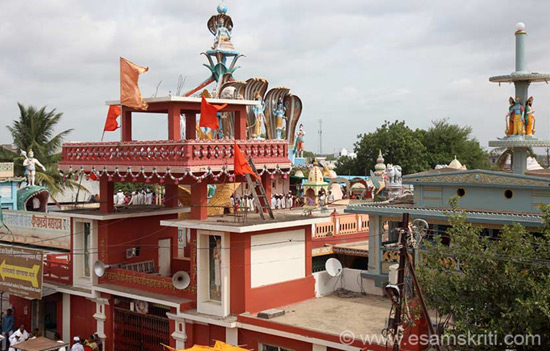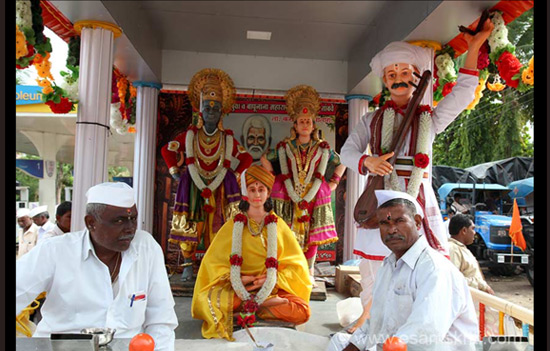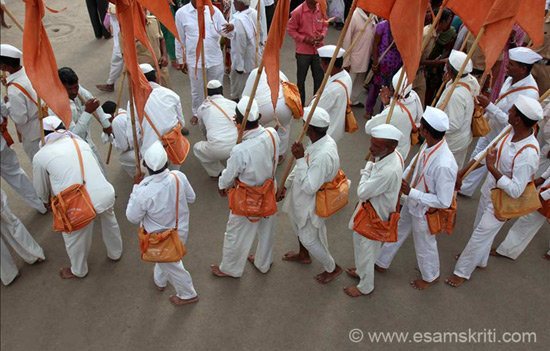Whenever I hear of Panduranga Vithala, my mind goes back to village called Mohol, near the holy city of Pandharpur. My father was the branch manager of the State Bank of India at Mohol. I had my primary education in this village. Whenever we had guests, a visit to Pandharpur was a must. Pandharpur is the abode of Sri Vitthala, born Vithoba, who is believed to be the essence and synthesis Vishnu and Krishna. My father was born on the auspicious day of Ashadha Ekadashi. So, my grandmother fondly named him Pandurang. I remember my father performing the maha-puja of Vitthala. I stood near him. The priest gave me small quantities of milk, curd, sugar honey, and ghee to apply on the image of the deity, as that part of the Panchamrita Snana by devotees is not allowed. The prohibition became necessary for protecting the stone image of Sri Vitthala.
Ashadha Ekadashi is a day of great celebration and jubilation at Pandharpur, when the Varkaris - devotees of Vitthala who gather from all over Maharashtra, walking all the way from their homes to Pandharpur, have a holy darshan of their beloved deity. I remember the massive influx of devotees, the enormously crowded streets, and the canvas tents for medical aid and vaccination. The road from Mohol to Pandharpur was lined with neem trees casting their reticulated shadows on the ground. I can still hear the soft rustle of delicate green leaves, smell their medicinal aroma, and see the yellow seeds profusely scattered under the trees. Pandharpur makes me nostalgic.
The roads leading to the main temple of Vitthala was paved with cobblestones. Outside the temple were small shops selling thick garlands of tulsi leaves, kumkum, abir bukka- used for the auspicious marks on the forehead, and sweetmeats- peda, sugar, candy, and the like. The air would be thick with the fragrance of tulsi. Even today, devotees find the whole atmosphere charged with devotion, vibrant with bhajans and kirtans, reverberations with the melodious beats of dhol, pakhawaj, mridanga, tal, and chiplya-drums and cymbals.
Pandharpur is full of temples. One of my favorites is the temple of Takpitya Vithoba (Vithoba who drinks buttermilk). Tradition relates this deity to a simple woman devotee of yore. If for some reason, she could not go to the main temple for darshan, she would offer a mixture of buttermilk (tak) and ground lahi (parched jowar, wheat, or paddy) as the naivedya (food offering) to Vitthala at her own home. And the deity, attracted by her ardent and pure devotion, would come to her house and relish the food. The shrine of takpitya Vithoba was built by a Brahmana widow named Radhabai in 1540 C.E. Devotees can still get to see the stone bowl that she used for offering food.
The math of Kaikadi Maharaj is a great attraction for children at Pandharpur. It has various brightly colored images and paintings of various scenes based on Puranic descriptions. The pictures depicting the punishments supposed to be meted out to people in hell for their past wrongs are awe-inspiring and leave indelible impressions on the minds of children.
 Kaikadi Maharaj Math
Kaikadi Maharaj Math As I grew up, I developed a keen interest in the cultural, social, and historical aspects of the Vitthala cult. I was fascinated by the enormous numbers of Varkaris, hearts full of love, trekking speedily to see their very own Vithai Mauli (Mother Vithoba), putting up cheerfully with all the difficulties and inconveniences of a long journey. When we read Sant Jnaneshwar’s virahinis (philosophical poems dealing with the pangs of separation from God) or Sant Tukaram’s abhangas (a particular metrical composition in praise of the deity), we can feel the fervor and intense longing for the supreme presence. Jnaneshwar says, ‘pailatoge kau kokatahe, shakun gem aye sangatahe; the crow is calling on the other side, predicting some auspicious happening. He wishes to adorn the feet of this crow with gold, for it is telling that ‘Pandharirau (that is, Vitthala) would be coming home as a guest’. Tukaram says, ‘bhetilage jiva lagalise asa; the jiva is longing to meet you, O Lord.’ A remarkable intensity of emotion and agony - generated by the separation from vitthala-is expressed through these simple but penetrating words. What, in reality, is the nature of Vitthala? For saints, he is the rajasa and sukumara, handsome and youthful, giving rise to spiritual restlessness and passion in the very depths of the hearts of numerous devotees.
Maharashtra has a unique tradition of bhajan. How can one forget the impact of the forceful melody of Pandit Bhimsen Joshi’s abhangavani or of the abhangas sung by Lata Mangeshkar?
Pandharpur: the Holy City
The principle deity of Pandharpur is Sri Vitthala. The chief priests are from the Badve family. The front portion of the temple of Vitthala is known as Gad or fortress. The temple has three doors each on its eastern and northern sides, and a door each on the south and west. The main door on the eastern side is the one frequently used, so it is called the Mahadwara. It is also called Namdev Darwwaja, Namdev’s door. Near the Mahadwara, there is the Samadhi-pitha (memorial) of the Saint Chokhoba. There are twelve steps to reach it. The first of these steps is known as Namdevchi Payari (Namdev’s step). Sant Namdev left his mortal coil at this very place. A brass image of his face is installed here. Namdev firmly believed that if he were to receive the touch of the ardent devotees of Vitthala he would certainly be liberated. This step is sacred to the devotees. They take care not to step on it.
 Centre of pic is Sant Dynameshwar, right is Sant Tukram. Pandharpur Wari 2015
Centre of pic is Sant Dynameshwar, right is Sant Tukram. Pandharpur Wari 2015As we move on, we come to the mandap (porch) that serves as the nagar-khana - room for the drums and other instruments of the temple band. Next, we enter the chowk - the temple courtyard. The chowk is lined with several owaris - rooms meant for accommodating pilgrims and resident devotees. The owaris have been framed in wood by the Badve family. The Samadhi-pithas of Sadhu Prahladabua Badve and Kanhaya Haridas can be seen here. To the west of the mandap are two dipamalas - stone pillars for lamps lit on festive occasions. The wooden mandap also has a small shrine to Garuda and Maruti Hanuman, each. The Hanuman image was installed by Samarth Ramdas. Next, we pass the images of Jaya and Vijaya - deities who protect the temple, and reach the Solakhambi mandap (sixteen-pillared hall). Scenes from the Krishna-lila, images of Matsya, Kurma, and other avataras, and decorative floral designs are carved on these pillars.
According to researchers, this mandap was constructed in the Muslim era. The Garuda-khamb, covered with gold and silver plates, is the important pilar here. Garuda is the vehicle of Bhagavan Vishnu. He was a great devotee. So, the devotees embrace this pillar lovingly and then move onwards for darshan of Vitthala. The entrance to the shrine is to the west, through the door known as Rupyacha Darwaja (the silver door). On crossing this door, we reach the Ckahowkhambi mandap (the four-pillared porch). The Hatti Darwaja (elephant door) with carved elephants on both sides is to the south. The image of Vithoba is three and half feet tall and bears a shivalinga on the head. Around his neck, vitthala has the kaustubha-mani (a precious gem that was obtained during the mythical churning of the ocean) and his breast is adorned with the footmark of his devotee, known as Vastsalanchhana. The back drop of the image is formed by a Prabhaval, a decorative silver plate.
If we approach the Vitthala shrine from the southern door, we get to see the image of the saint woman- Kanhopatra in a niche on the wall. Behind the Vitthala shrine to the northwest, is the shrine to Rukmini, the consort of Vitthala. The shrines to satyabhama and Rahi are also close by.
That Rakhumai (the popular name of Rukmini) and Vithoba have separate shrines is a unique feature of this temple. There is a story among the Dhangars - who have traditionally been shepherds, herdsmen, and wool weavers, regarding this permanent parting. The story goes like this: Vithoba’s wife actually had the name Padmavati and they, Vithoba and Rukmini represent humans with divine qualities. So was fondly called Padubai. She always had to remain busy with her household chores. Once she was extremely tired and so refused to serve Maliraya, a guest of her husband. Vithoba turned furious and pronounced a curse that she would go mad and be separated from him. Vithoba’s curse came true. Padubai went to the forest and died under a tamarind tree. Her parents Janakohi and Kamalaja ran to see her when they heard of this sad turn of events. But Vithoba assumed the form of a snake and sat blocking the way. He would not allow anyone to go near Padubai’s corpse, even as kites and vultures ate it up. He then had clouds pour showers and wash Padubai’s bones to the sea. This tragedy badly upset Maliraya as he felt he had caused it. So he undertook penance by the seashore for the next twelve years. The sea was pleased with his tapas and Maliraya requested the sea to return Padubai’s bones. He then reverentially immersed these bones in Padmatirtha, a lake by the Chandrabhaga River, and a beautiful lotus emerged from its waters.
Meanwhile, Vithoba was tormented by the separation from Padubai. He was wandering restlessly in search of Padubai when he reached the shores of Padmatirtha and saw the beautiful lotus. He plucked it, and Padubai appeared before him bearing the name Rukmini. But Vithoba had no attachment for samsara anymore. He said, ‘My words cannot be untrue. Our household life has come to an end. We shall not be staying under one roof. But we shall meet everyday, communicate with each other, and dedicate our devotees.’ This is how their shrines got separated.
This story has a symbolic meaning. Vithoba is the symbol of non-attachment; he is portrayed as the conqueror of kamini and kanchana. Together, Vithoba and Rukmini represent humans with divine qualities. So, they accepted their suffering and a life of duty, devotion, forgiveness, and truth. They decided to live for the sake of their devotees.
Satyabhama is the wife of Krishna and Radha is his dear friend. Rahi is Radha. In the stories and traditions of Maharashtra, Rahi is the wife of Vitthala.
Besides these main temples are the images of Kashi Vishwnatha, Rama-Ladshmana, Kalabhairava, Rameshwara Shiva, dattatreya and Narsoba in six different rooms. A seventh room lies vacant. These rooms were built by Kanbawa Badve. There is a narrow passage between these rooms and the Solakhambi mandap. At the eastern end of this passage, there is piece of inscription known as Chauryanshicha Shilaledh (the stone inscription of eighty-four).
There are numerous other temples in Pandharpur. These include the temples to: Takpitya vithoba, Pundalika, Vishnupada-Venunada, Gopalakrishna of Gopalpur, and Muralidhara; Gondavalekar Rama; Malikarjuna, Bhuleshwara, Tryambakeshwara, Koteshwara, Vateshwara, and Amriteshwara; Nagareshwara Sarkarvada Mahadeva, Bhadalyacha Mahadeva, Garecha Mahadeva, and Bericha Mahadeva; Ganapati, shakambhari, Chandrabhaga and Paravaril Datta; Panchamukhi Maruti, Tambada Maruti, and kala Maruti; Khajgivale Murti; Padamvati, Vyasa, Ambabai, Lakhubai Yamai and Jyotiba, and Namdev. There is also the Samadhi-pitha of Sridhara Swami and Mahaprabhuchi Baithak (Mahaprabhu’parlour).
Vithoba’s Image
Researchers hold varying opinions about the history of the Vitthala temple and image. The main temple was built by the Yadavas of Devgiri in the twelfth century, though the deity was well-known several centuries earlier. During the Muslim invasion in the sixteenth century, the image had to be kept hidden due to the fear of desecration.
There is another interesting debate about Vitthala. There are arguments suggesting that Vitthala is a Karnataki or Kannada deity rather than a Marathi deity. Jnayaneshwar says: “kanada ho vitthalu karnataku, yene maja lavile vedhi; this Vitthala who is kanada (difficult to understand) and karnataku (from Karnataka, or kara nataku, playful) has put me in the state of constant remembrance.’ Saints like Eknath and Namdev have also referred to him as kanada vitthala. Those who vouch for his being Marathi emphasize that kanada means ‘inaccessible, indescribable’.”
Geographically, Pandharpur is on the border of Maharashtra and Karnataka. The ancient name of Pandharpur was Pandarage. So the Karnataki shades of PanduraVitthala cannot be easily wiped out. In fact, a closer look at the history of Pandharpur reveals that Vitthala has also had Buddhist and Jain aspects.
To the saints, there is no point in such regionalism. All of them bear a tender affection and innocent love for Vitthala. For them, Vitthala is ‘savale parabrahma; Para-brahman with a dark complexion; he is Hari in the form of a gopa (cowherd), he is also Shiva and Vishnu. There are many Kannada saints and poets who have sung the glory of Vitthala with loving devotion. In his poem ‘Panduraanga Mahatmyamu’, the Telugu poet Tenali Ramadrishna too sings praises to Vitthala: “pundarikundu kshetra palundu golichi yunda navyaktamukhya samyuktundaguchu pandurangandu bhaktakalpandrulila nishthaphalasiddhi dorahattinchu ninti”
(O Parvati), accepting the services of Pundarika and kshetrapala (Kala-bhairava), becoming the wish fulfilling tree by assuming a subtle body for the sake of devotees, fulfilling their wishes, the deity Panduranga resides in that temple.
This shows that Vitthala is an impressive symbol of synthesis. He became the centre for the emergence of a unique social and spiritual movement. The devotee saints declared war against hollow rituals and hypocrisy. They were not interested in the shallow vulgar show of erudition. On the contrary, they wanted to experience the spirit of the ‘one without a second’ in their own life. Why are temples needed? Because temples and deities represent humbleness, which, along with goodness and the spirit of synthesis, we need to protect. If this purpose is not served, then sacred places and temples are mere heaps of stone. Tukarma says: “tirthi dhondapani, deva rokada sajjani; holy places are made of mere stones, God is in wisdom and in the pious.”
 Varkaris at Pandharpur Wari 2015
Varkaris at Pandharpur Wari 2015Vithoba, Vitthala, Panduranga
The Varkaris fondly address Vitthala as Vithoba Mauli (Mother Vithoba). According to the legend, he is related to both Shiva and Vishnu. Panduranga is another of his popular names. Scholars have provided interesting insights into the etymological meanings of these names.
If the image of Vitthala is black, why is he called Panduranga (white colored)? R. C. Dhere has pointed out that though the Skanda Purana mentions ‘Panduranga’ as a synonym for ‘Vitthala’s shrine’, just as ‘Kashi Vishwanatha’ means ‘Vishwanatha of Kashi’, ‘Panduranga Vitthala’ means ‘Vitthala of Panduranga.’ According to the deshinamkamals of Hemachandra, the deity is Pandarango Ruddammi and is related to Rudra-Shiva. A copper plate dated 516 C.E. records the grant of five villages is Pandarangapalli. Similarly, there is the Sanskrit-Kannada inscription (1236 C.E.) carved on a beam in the Solakhambi Mandap of the main temple of Vitthala where Pandharpur is referred to as Padaranga.
In a copper plate found at Bendigere near Belgaum, Pandharpur is referred to as Paundarika Kshetra and Vitthala is described as Vishnu. Elsewhere, Pandharpur is called Phagnipur. In the Jnaneshwari, King Ramadevarai Yadava is described as ‘pandhari-phada-mukhya. Pandhari refers to the tutelary village god and phada is a place of public business. So, Ramadevarai was the chief of the business centre Pandharpur.
Several etymological derivations have been suggested for the term Vitthala. The deity stood and waited on a brick (vit in Marathi) thrown by his great devotee Pundarika, so, he is termed as Vitthala.
Tukaram says, ‘vicha dela thoba, mhamoni nav to vithoba’; the learned say that Vitthala is one who is gracious towards innocent people devoid of knowledge. A more esoteric explanation is as follows: vit means knowledge and that means shunya (void); so vittha signifies ignorance and the suffix la refers to the one who accepts. So, Vitthala is the one who protects ignorant jivas. Or, as he is all-pervasive, resides in akasha or viyat-sthala (space), and is absorbed into akasha, he is Vitthala.
In contrast to the above explanations, there is a general agreement among linguists that the word Vitthala is related to the Prakrit for Vishnu vittha (Vishnu -> Vishtu -> Bitthu -> Vitthulu -> Vitthalu -> Vitthala). Rakhumai is Vitthala’s spiritual consort. This name is derived from lakshmi (Lakshmi-> Lakshma-> Lakhama-> Rakhama-> Rakhuma). If Vishnu is Vitthala, his spouse must be Lakshmi or Rakhumai.
But to the simple-hearted varkari devotees, these analytical details are not of much interest. To them Vitthala is their mother, Vithoba Mauli.
Also see pictures of
1. Pandarpur Wari
2. Pandarpur Ringan
Editor: This article was first published in 2008. Pictures added in 2017.
This article was first published in the Prabuddha Bharata, monthly journal of The Ramakrishna Order started by Swami Vivekananda in 1896. This article is courtesy and copyright Prabuddha Bharata (www.advaitaashrama.org). I have been reading the Prabuddha Bharata for years and found it enlightening. You can subscribe online at www.advaitaashrama.org. Cost is Rs 180/ for one year, Rs 475/ for three years, Rs 2100/ for twenty years. To know more Visit here